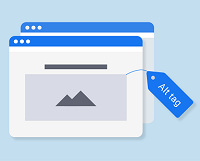The One Thing People Who Are Blind Have in Common With Search Engines
by Beth
 Here’s a New Year’s resolution that’s a cinch to follow: vow to start using html code to identify images and graphics for users like me, who are unable to see them. Your reward? You’ll likely increase your SEO (Search Engine Optimization) scores as well.
Here’s a New Year’s resolution that’s a cinch to follow: vow to start using html code to identify images and graphics for users like me, who are unable to see them. Your reward? You’ll likely increase your SEO (Search Engine Optimization) scores as well.
Let me try to explain. Many of us who are visually-impaired or blind use screen readers on our computers and smartphones. When we visit a website, as long as you’ve used alt text, our screen readers will read the alt text out loud so we know what images you’ve used. Sites that don’t use alt text correctly (or don’t use it at all) risk leaving us, quite literally, in the dark.
Turns out we’re not the only ones who can’t see images on your website: search engines can’t “see” them, either. Adding alt text and, when possible, describing images in a way that includes a keyword you’re targeting, is a great SEO tactic.
I like to think of this alt text tactic as an example of accessible technology is like accessible design. Like to skateboard? Use luggage with wheels? When you take walks, are your kids in strollers? If so, you have the Americans with Disabilities Act to thank for requiring curb cuts.
The Americans with Disabilities Act also brings you closed captioning, which means bars, restaurants, health clubs and airport lobbies don’t have to crank the volume for people who want to keep up with news events, sports and weather.
So now, with this alt text idea, I can say accessible technology is for everyone trying to increase SEO scores. Who knew? Not me! But just like curb cuts and closed captioning, alt text provides unintentional benefits to people whether they have disabilities or not. I. Love. It.
A little research on all this led me to the Perkins School for the Blind’s Technology blog. I’ll say goodbye here with a recommendation that you read a post there to learn best practices when writing alt text. Then watch your SEO scores zoom upward as search engines – and people who are blind – can read them.






